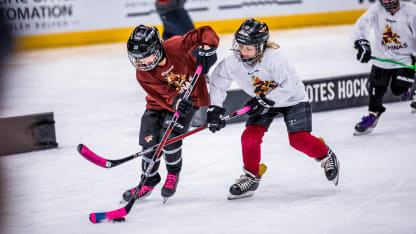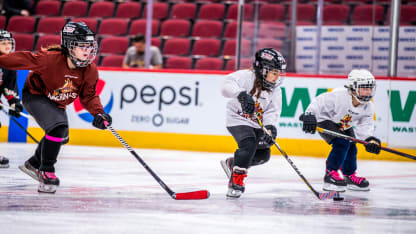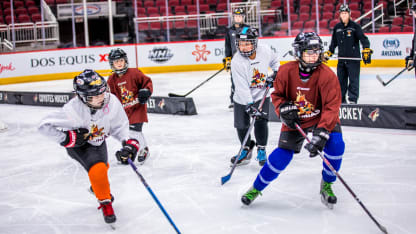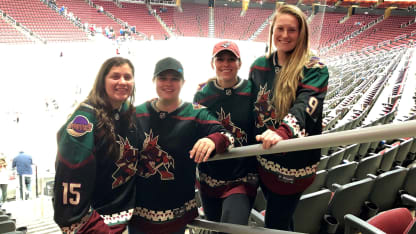When Lyndsey Fry came back to Arizona in 2015, one college degree from Harvard University and an Olympic silver medal under her belt, it felt right to come back home.
She'd spent years playing hockey in Colorado in high school, before traveling even farther to get her undergraduate degree in Boston, Massachusetts. Then came the trip to Ottawa for a gold medal at the World Championships, followed by a stop in Sochi, Russia to pick up that Olympic silver. It was a whirlwind of success and progress, bringing a girl from the desert to the far reaches of the globe to skate out on the ice.
Arizona Kachinas: The overhaul of girls hockey development in the desert
The story behind the workings to build a foundation for girls hockey in Arizona

By
Taylor Sedona Clark and Catherine Silverman
Now, though, she wanted to head back to her roots. She wanted to get her graduate degree at Arizona State, where she got a chance to play inline hockey with her younger brother. She wanted to map out her next steps, spending more time with her family.
Most importantly, though, she wanted to make a difference. Nearly two decades after she first stepped out on the ice herself, Fry was determined to make hockey easier to access for young girls in her home state.
The idea of starting a program from the ground up became her mission. Instead of focusing on forming only a competitive, higher level program, often termed a catching program, she would start at the very beginning level, providing girls with the opportunity to step on the ice as early as possible. From there, the program would grow with the population; as more girls were taught to skate from day one, more girls would fill programs at the higher levels all on their own.
Fry graduated from Harvard in 2015, returning to the valley nearly four years ago now. Since then, Fry has put in a massive amount of work -- and with a small but crucial group of fellow visionaries, that initial seed of a dream finally saw the light of day this year.
"You have no idea what you're getting yourselves into."
Fry returned from college determined and passionate as ever - and luckily, she found an equally passionate voice of support in Coyotes Director of Hockey Development, Matt Shott.
At the time, Shott was already one of the biggest advocates for grassroots hockey development across Arizona. He was coaching the Lady Coyotes when Fry returned from college, but the girls hockey scene was little better than it had been for Fry herself growing up; even with coaches like Shott and Natalie Rossi at the helm, programs were fragmented and struggling to stay afloat. Shott had been working for a while to grow Arizona hockey from the ground up, and when Fry returned he saw the perfect opportunity to form a program that could really make a difference. After approaching Fry it would take a couple of years and some hard work, but Shott's vision for a girls hockey developmental program materialized. Fortified by Fry's passion and talent, and the Small Frys program was born in 2018.

© Janelle Etzel
The road to starting Small Frys was longer than the two expected, and had a couple of setbacks. The pair set up a meeting with Lyndsey's dad, who had run the Chandler Junior Polar Bears on the southeast side of Phoenix, and the Polar Bears VP, Jackie Hodgens. They hoped that Shott's connection to the Arizona Coyotes could help them leverage to get the team's support for resources, and they were ready to get the program off the ground.
"We said, 'girls hockey is growing. We see the growth, we see the numbers exploding, but how do we get them all in one place? How do we get them all under one umbrella, and how do we give them the greatest opportunity we possibly can?'" Fry said.
"So we met with my dad and Jackie Hodgens back then in 2015, and we said 'this is what we want to do, how do we do it?' Like, let's go!"
The pair assumed it would take about a year from that first meeting to take their idea and get a program operating on the ice. Even without the funding, Shott remembers, they figured that a year was a realistic goal.
Instead, they were given a dose of reality.
"You have no idea what you're getting yourselves into," Lyndsey's dad explained.
"You guys are so far away," Shott said. "That was the first thing he told us. He said, 'we're not trying to tear you down - but you guys are that far off."
He wasn't wrong. It's been four years since that first sit-down at a Tempe-area California Pizza Kitchen; the meeting, while harsh, was a necessary dose of reality.
Grand achievements rarely happen overnight, though.The program they envisioned needed to be established, but they would have to go about it the right way -- and four years after they sat down to figure out what it would take, they've managed to flip girl's hockey in Arizona completely on its head.
Building a program from the bottom up
The youth hockey scene in Arizona has exploded in the last decade, skyrocketing from a bare-bones landscape to one with thousands of registered skaters and multiple boy's teams at every age group and level.
Unfortunately for girls hockey, the progress has been heavily stagnated by a lack of establishment of the very basic bottoms tiers of a hockey organization.
The problem that Fry immediately identified was where the emphasis for development was being placed. Most -- if not all -- of the women's hockey programs in the state's past have been what are known as "catching programs", which cater to older girls. While a new group of passionate advocates were willing to establish a new 12U, 14U, or 16U girls program every few years, though, no one had taken the time and effort to establish a program for girls at the bottom of the pyramid, fleshing out participation at level one.
"We kind of have the older stuff for the girls, so that when they can't play boys hockey anymore we just catch them from that or pull them out from there," explained Fry. "That's kind of how girls hockey has done their 'recruiting'. So [myself and Matt Shott] said, 'let's flip that on its head, and let's do the Small Frys program'."
The Small Frys program was created to keep girls interested once they graduated from the Learn to Play program, called the Little Howlers, which provides rudimentary skating and hockey skills for kids ages five and up. It gave little girls the opportunity to keep playing with other girls after they graduated from the Howlers, eliminating some of the pressure and stigma that can come with the girls needing to join a boys team or leave the sport altogether.

© Janelle Etzel
Neither Fry nor Shott could have imagined the success the program would have. Small Frys received funding from the NHL through an IGF grant, and within the first year had graduated 56 girls -- double what they had projected would come out of an inaugural season. The program, which was run entirely by an all-female staff, was so successful that the NHL stepped in to observe it for future implementation; after seeing how many young girls responded well to the program, the NHL hopes to model similar programs after it across North America.
The growth of girls developmental programs is going to skyrocket as programs like Small Frys blossom and establish a strong presence. Most recently Laura Jordan, Fan Development Assistant with the Chicago Blackhawks, and Mary DeBartolo, Youth Hockey Supervisor with Fifth Third Ice Area, visited Fry and Shott in Arizona. The goal of their trip was research, before they launch a similar program titled "Golden Coynes", named aptly after Olympic gold medalist Kendall Coyne Schofield, who was born in Illinois and has strong hockey ties to Chicago. Their visit was filled with observing the Kachinas and Small Frys programs in action and learning directly from Fry and Shott how they approached building the programs and what led to their outstanding success.
While growing girls hockey in Arizona was the main priority of Shott and Fry when starting Small Frys and now launching the Kachinas program, the opportunity to be an example and a resource to aid in the expansion of girls hockey programs across the nation is not taken lightly. Their willingness to help and determination to improve the game for everyone is something the Blackhawks greatly appreciate as they embark on their own endeavor.
"When it comes to growing the game we love, all of us in the NHL are on one team," said Annie Camins, Sr. Director of Fan Development for the Chicago Blackhawks. "We are very excited to be expanding our all-girls programming in Chicago this summer and would like to thank the Arizona Coyotes organization for letting our staff visit the Small Frys program and sharing their best practices."
The creation and unparalleled success of Small Frys was a monumental accomplishment on its own, giving Fry and Shott the reaffirmation -- this is what the state needed.
It was just the first step, though. To truly see that four-year goal through to a successful implementation, the Small Frys had to be just the beginning.
Those 56 girls that completed the entire Small Frys program made it clear that they were interested in taking the next step. Fry leveraged that loyalty, combined with the impressive inaugural year numbers, and officially launched the Kachinas program this season.
The Kachinas officially started their year in August and wrapped up a couple of weeks ago. Though the players couldn't play in any games outside of intrasquad scrimmages due to association restrictions -- but still, 40 girls stuck with the program. The players and their families put their trust in the vision Fry and Shott had for girls hockey, and they wanted to be a part of it -- so they played in unofficial scrimmages and practiced without official games to prepare for, biding their time until the Kachinas got their approval to flesh out the program from top to bottom.
At the very bottom is the Small Frys, who take feeders from the Little Howlers program and develop additional hockey skills for the girls before they prepare to play official games.
After that comes the Kachinas, which fills the void that previously existed between the introductory learn-to-play programs and the catching programs at the higher age groups. Fry estimates that about 60 percent of the girls who played in the Kachinas development scrimmages this year were graduates from her Small Frys program, while the remainder were girls who had attended camps with Fry in summers past before returning to play boys hockey. The Kachinas are set to be split into two programs, offering the Kachinas Development program for new players while simultaneously offering the Kachinas Elite for girls who want somewhere to go after playing either AA or AAA boys hockey.

© Arizona Coyotes
The program then established a Kachinas high school hockey program, which will provide girls with an opportunity to play in high school without needing to play for a boys team, and finally implemented a merger with the AZ Lady Coyotes -- which will serve as the tip of the pyramid, offering a Tier II girls program for the skaters once they reach that level.
The Kachinas were officially approved by the Arizona Amateur Hockey Association this spring, so they'll be allowed to play official games starting this summer -- and the numbers are promising. An estimated 128 girls are registered to skate from their earliest strides to their most competitive high school practices, and the official establishment of the program moving forward should see that number go up with each coming year.
"I just want to help even one girl get from hockey what I got from it."
Shott and Fry were a two-person team when they sat down for their first meeting in 2015, but the support staff has grown in the years since. They've added a trio of additional women to the directorial staff for the program, fleshing out a legitimate offering of resources for every girl that comes through the program.
Working with the older girls and managing social media will be Co-Director of Hockey Operations and Director of Social Media and Marketing Vanessa Maines, who fell in love with the idea of growing the game in Arizona after coming from a hockey-heavy upbringing in Massachusetts.
She'll be joined by long-time friend Natalie Rossi, who will serve as Co-Director of Hockey Operations while focusing on the development of a strong, cohesive coaching staff that emphasizes consistent messages from the top to the bottom, while Fry's childhood best friend Erin Cain will round out the Hockey Operations directorial staff while also serving as Director of Fitness and Mental Performance. Maines brings a media career background, while Rossi has extensive experience coaching at every level and Cain has certification as a yoga instructor to go with experience running her husband's mental performance consultation company. Like Fry, all three played hockey through college at the NCAA level -- and with time spent playing everywhere from New Jersey and Massachusetts to Colorado and Arizona, the four women both possess a passion for the game and the diverse experience to help a program grow even in the desert.
The Kachinas are a launching point for the region, which has lagged so severely in the growth of women's hockey compared to men. The goal is for them to provide a stable, sustainable model for the southwest, showing how to build up the numbers in order to retain talent for competitive girls' teams by developing programs from the youngest skaters on up.
It took nearly half a decade to make sure it was developed properly, but the Kachinas should now provide a sustainable pipeline for girls in Arizona to play competitive hockey, no matter the level they want to reach in the end, from childhood up until they reach college. They'll be able to provide a central location for the teams in California, Utah, Colorado, and New Mexico, enabling girls to play affordable hockey without needing to board planes back east just to find competition.
More importantly, though, the program will provide girls in Arizona with the opportunity to play free of intimidation or pressure. They plan to provide a financial discount to girls who double roster on boys teams, ensuring that no girl has to pick between playing with other girls and being able to afford playing both boys and girls hockey, and they hope to retain enough girls from the Small Frys up through high school to field a handful of teams at every age group. The girls who want to play without leaving the state will have options, no longer forced to choose between living and home and playing good hockey. And perhaps best of all, they'll be able to grow and develop as a team, making friends that they can skate with for as long as they want to play.
It took a while to get it off the ground. But for the girls in Arizona, getting the program right -- from day one -- is worth it.












